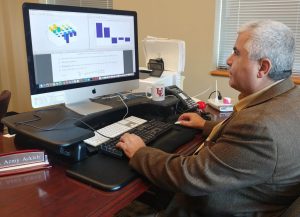Study Analyzes How Environmental Disturbances Affect Whale Recovery
– AUGUST 14, 2018
Researchers modified a matrix population model to include the impact of a disturbance and study the recovery process for large marine mammal populations. They applied the model to identify key components in the recovery process for Gulf of Mexico sperm whales following a disturbance such as the Deepwater Horizon oil spill. Model simulations indicated that the magnitude of a disturbance’s impact had a greater effect on recovery time than did the duration of an event’s impact. Recovery time was also sensitive to the initial whale population’s structure and vital rates, with mature reproducing females contributing the most to shortening recovery time. Smaller populations, such as the sperm whale, were associated with larger variations in average recovery time due to their sensitivity to birth and death variations. This improved understanding of how whales recover from disturbances can help guide conservation and response efforts. The researchers published their findings in Natural Resource Modeling: Sensitivity analysis of the recovery time for a population under the impact of an environmental disturbance.
Whale population studies from before and after the Deepwater Horizon incident indicate that sperm whales were present in affected areas. Understanding how vital rates are impacted by a disturbance is critical for calculating a population’s recovery time. For large marine mammals, their habitat and behavior make it complicated or sometimes impossible to quantify changes in vital rates following an environmental disturbance. Matrix population models are well-established tools to explain and predict population dynamics and explore management strategies for at-risk species. These types of models can provide useful insights even when exact data is unavailable. However, these analyses often assume a constant environment and, therefore, do not work for scenarios involving populations whose environment is changing due to a disturbance.
In this study, researchers addressed this challenge by introducing a disturbance into the matrix model, thus assuming a non-constant environment. From this model, they derived a formula for the recovery time in order to examine a populations’ recovery ability and how different factors affect the recovery process. The team derived formulas for calculating the sensitivity and elasticity of recovery time to changes in the initial population structure, vital rates, and event severity. They then applied the formulas to study how the Gulf of Mexico sperm whale population might recover after a disturbance such as the Deepwater Horizon spill.
“Our study is aimed at providing tools for analyzing different strategies for mitigating the impact of these disturbances and can be applied even when exact data on the disturbance is not available,” explained study author Azmy Ackleh. The sensitivity and elasticity formulations they modified provide a computationally efficient alternative to stochastic simulations for generating an average recovery time, and results can reveal which life stages are particularly important for population recovery.
“As the rate at which human activity affects the ecosystem grows faster, it becomes increasingly important to understand how populations may be impacted by anthropogenic and natural disturbances,” said Ackleh. “Our study suggests that management efforts should focus on reducing the magnitude of the impact of the disturbance, such as removing oil from the Gulf, rather than the duration of impact.”
The researchers noted that the model works under the assumption that there will be no more disturbances before the population has recovered and suggest that future work develop methods and techniques to address this issue.
Data are publicly available through the Gulf of Mexico Research Initiative Information & Data Cooperative (GRIIDC) at doi:10.7266/N7125R3R.
The study’s authors are A.S. Ackleh, H. Caswell, R.A. Chiquet, T. Tang, and A. Veprauskas.
************
This research was made possible in part by a grant from the Gulf of Mexico Research Initiative (GoMRI) to the Littoral Acoustic Demonstration Center – Gulf Ecological Monitoring and Modeling (LADC-GEMM)consortium.
The Gulf of Mexico Research Initiative (GoMRI) is a 10-year independent research program established to study the effect, and the potential associated impact, of hydrocarbon releases on the environment and public health, as well as to develop improved spill mitigation, oil detection, characterization and remediation technologies. An independent and academic 20-member Research Board makes the funding and research direction decisions to ensure the intellectual quality, effectiveness and academic independence of the GoMRI research. All research data, findings and publications will be made publicly available. The program was established through a $500 million financial commitment from BP. For more information, visit https://gulfresearchinitiative.org/.
© Copyright 2010-2018 Gulf of Mexico Research Initiative (GoMRI) – All Rights Reserved. Redistribution is encouraged with acknowledgement to the Gulf of Mexico Research Initiative (GoMRI). Please credit images and/or videos as done in each article. Questions? Contact web-content editor Nilde “Maggie” Dannreuther, Northern Gulf Institute, Mississippi State University (maggied@ngi.msstate.edu).






